The Great War Centenary
1917 - ExhibitionBoomtown - From
Front Line to White Lund
Gallantry
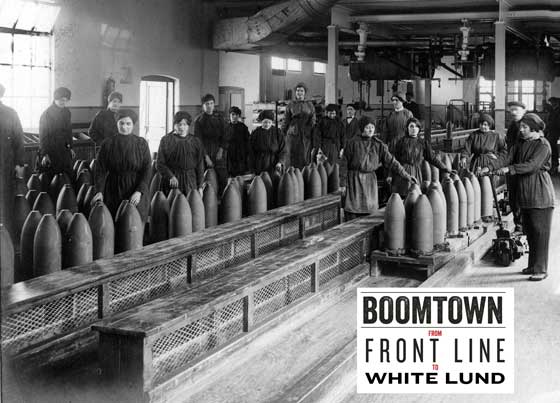
In the weeks after the explosions at White Lund the Ministry of
Munitions and the Home Office attempted to pin down exactly what had
happened and why. Eyewitness statements from workers and fire brigades
indicated that individuals had acted with great courage and devotion to
duty. It was well understood that they deserved public recognition.
The authorities had the difficult task of assessing individual
contributions and deciding on the type – and level – of award to give.
The Home Office recognised that:
‘It will probably be found that others besides those already put forward
by the Ministry are deserving of recognition. The conditions were so
appalling during the first 24 to 36 hours that almost everyone who took
part in the work of saving the magazines and fighting the fires would
seem worthy of distinction.’
The announcement of the awards was made on 7th May 1918. It maintained
the veil of secrecy stating only that they were ‘on account of their
gallant conduct on the occasion of a fire which occurred at a Munitions
Factory on the 1st October 1917.’
In the end four different types of award were made.
Edward Medal (Silver)
Only 25 silver Edward Medals were awarded between 1907 and 1949. Four of
these were awarded to White Lund heroes.
.jpg)
The Edward Medal of Police Sergeant Thomas Coppard in the collection of
Lancaster City Museum
Thomas Coppard, Police Sergeant, for his part in rescuing several
people from a blazing factory where he was one of the police guards
(medal in the collection of Lancaster City Museum)
Abraham Graham, Railway Shunter, for bravery working with Thomas
Kew
Thomas Kew, Engine Driver, who drove ammunition trucks full of
live shells out of the danger zone
Thomas Tattersall, Works Fireman, for bravery
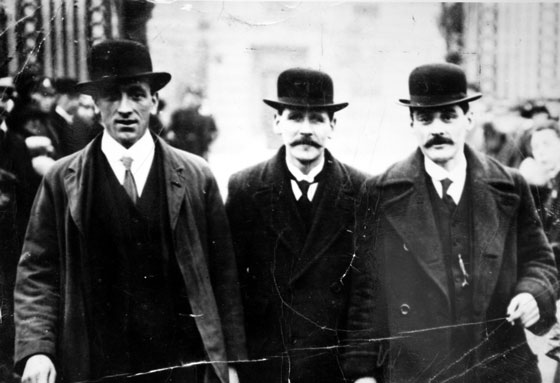
Albert Graham, Thomas Coppard and Thomas Kew leaving Buckingham Palace
after receiving their Edwards Medals on 7th May 1918.
King’s Police Medal
Fred Brocklehurst, Deputy Superintendent, Bolton Fire Brigade
William Bramwell Hodgson, Superintendent, Morecambe Fire Brigade
D’Arcy Benson Moffat, Superintendent, Vickers’ (Barrow) Fire
Brigade
Richard Newsham, Superintendent, Barrow Corporation Fire Brigade
George Albert Oakes, Chief Inspector, Liverpool Fire Brigade
Alonzo Savage, Superintendent, Preston Fire Brigade
Daniel Devine Sloan, Second Officer, Manchester Fire Brigade
William Andrew Wearing, Inspector, Lancaster Fire Brigade
Medal of the Order of the British Empire
Grace Calrow, Driver of the Factory Motor Car – ‘For courage and
devotion to duty at a fire at a filling factory, when she was on duty
continuously for forty-eight hours in circumstances of great danger.’
John Caton, Boiler Attendant – ‘Remained on duty the whole time
during a severe fire and explosion at a national filling factory in
spite of great danger.’
Alexander Chamberlain, Shift Engineer in the Power House –
‘Displayed conspicuous courage and devotion to duty on the occasion of a
very serious fire and explosion at a munition factory.’
Nurse Lily Cope, Factory Nursing Staff – ‘Behaved with great
courage on the occasion of a severe fire and explosion at a national
filling factory, performing her duties quietly and without regard to
personal safety.’
William Disberry, Pump Attendant – ‘Although 70 years of age, he
remained at his fire pumps the whole night on the occasion of a severe
explosion and fire at a national filling factory. The position was one
of great danger throughout.’
Sergeant Richard Garth, Lancaster Fire Brigade – ‘Behaved with
great gallantry on the occasion of a severe fire and explosion at a
national filling factory.’
William Heald, Feed Pump Attendant in the Power House – ‘Remained
on duty the whole time during a severe fire and explosion at a national
filling factory, in spite of great danger.’
George Hutchinson, Boiler Fireman in the Power House – ‘Remained on duty
the whole time during a severe fire and explosion at a national filling
factory, in spite of great danger.’
Jilbert Johnson, Works Police Constable – ‘Behaved with coolness
and resource on the occasion of a severe fire and explosion at a
national filling factory.’
George Nutt, Boiler Attendant in the Power House – ‘Remained on
duty the whole time during a severe fire and explosion at a national
filling factory, in spite of real danger.’
William Seery, Works Police Constable – ‘Displayed courage and
resource on the occasion of a severe fire and explosion at a national
filling factory. He was thrown down and injured by an explosion.’
Nurse Maisie J Shepherd, Factory Nursing Staff – ‘Behaved with
great courage on the occasion of a severe fire and explosion at a
national filling factory, performing her duties quietly and without
regard to personal safety.’
Charles Taylor, Foreman (medal in the collection of Lancaster
City Museum) – ‘Displayed great coolness and courage in carrying out
vitally important repairs on the occasion of a fire at a national
filling factory whilst a large number of shells were exploding in the
immediate neighbourhood.’
Richard Taylor, Fireman in the Factory Fire Brigade – ‘Displayed
great courage and resource on the occasion of a severe explosion at a
national filling factory’.
Mary Agnes Wilkinson, Telephonist (medal in collection of
Lancaster City Museum) – ‘Rendered invaluable service at a telephone
exchange on the occasion of a fire and serious explosion at a munitions
works close by, proceeding to her post through the danger zone and grave
personal risk’.
The Medal of the Order of the British Empire awards were published in
three of the supplements to the London Gazette:- Mary Wilkinson – 4th
January 1918; Grace Calrow and John Caton – 11th June 1918 and all other
recipients – 3rd June 1918.
Lord Shuttleworth, Lord Lieutenant of the county, distributed many
awards for bravery and paid tribute to the valour and deeds of heroism
of women and men. Mary Wilkinson received hers on 20th April 1918, many
others had to wait until 3rd December 1918.
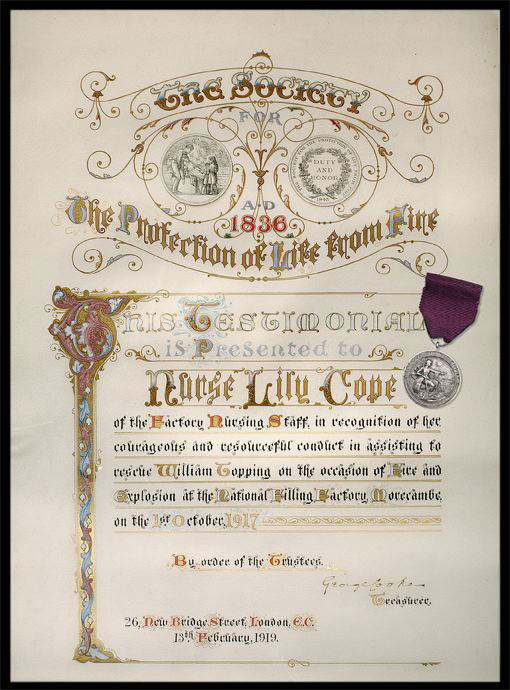
Certificate to Nurse Lily Cope, with her medal.
Gold watches
Alfred Adage
Ernest B Blackwell
Albert Dudson
George Duxbury
Alfred Gill
Fred Harrison
Edwin Howarth
William G Kirkup
William Lee
Edward Legge
Howarth Nuttall
Albert Shaw
Herbert Arthur Tennent
Leonard Thomson
William Tuley
James Vysick
Thomas Walker
Letters of Commendation
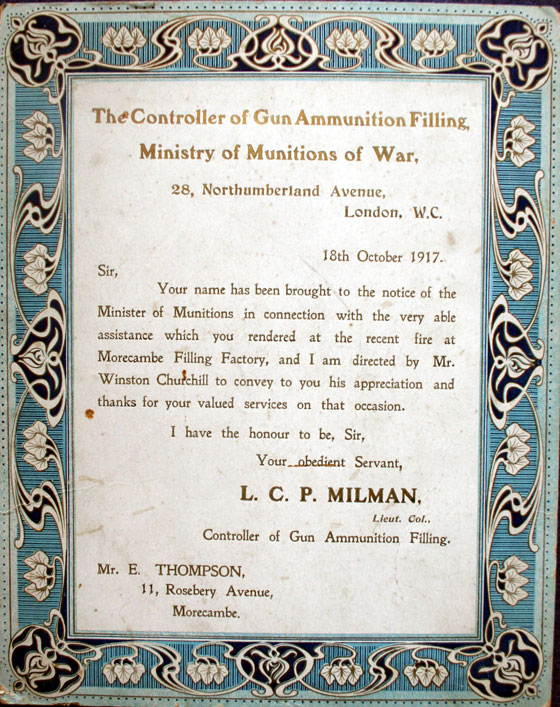
Letter of appreciation from the Controller of Gun Ammunition Filling,
Lieutenant Colonel L C P Milman, to Mr E Thompson, one member of the
Works fire brigade.
Accession Number: LM2001-61-2
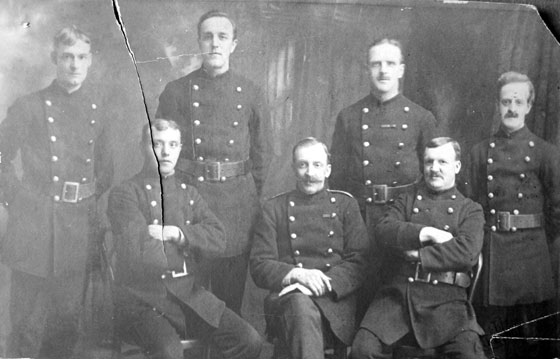
Members of the White Lund Works Fire Brigade, including Mr Thompson who
received the letter above.
Accession Number: LM2001-61-1
© Images are copyright, Trustees of the King's Own Royal Regiment Museum.
You must seek permission prior to
publication of any of our images.
Only a proportion of our collections
are on display at anyone time. Certain items are on loan for display
in other institutions. An appointment is required to consult any of
our collections which are held in store.



.jpg)



